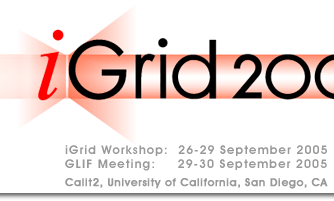News Releases
First multicast of 1.5Gbps HD video and first multipoint videoconference using uncompressed HD
San Diego, CA, September 28, 2005 - ResearchChannel, in partnership with the Asia-Pacific Area Network, the University of Michigan, the University of Washington and the University of Wisconsin-Madison, plan to demonstrate a global high-definition videoconference across IP networks Sept. 28 at the iGrid 2005 conference in San Diego. Attendees will interact with colleagues from Japan, Michigan, Washington and Wisconsin.
Until now, videoconferencing has been a poor substitute for meeting in person with colleagues. Low-quality video coupled with slow response times make videoconferencing inferior to real-life communication. Having an effective tool for communicating with colleagues from around the globe is vital. This ResearchChannel demonstration will bring the feeling of real-life, in-person interactions to videoconferencing. In this virtual meeting, colleagues at each site will be able to interact with one another in real time by way of high-definition video with very low latency, resulting in speed and detail that approximate a face-to-face meeting.
“This demonstration in HD collaborative environments will help raise videoconferencing to the same level as conversing with colleagues who are in the same room,” said Michael Wellings, ResearchChannel director of engineering.
Each site will communicate with the other sites in a very high-quality videoconference environment. This communication will be two-way, with completely uncompressed HDTV. This demonstration is the first multicast of 1.5Gbps high-definition video and the first demonstration of a multipoint videoconference using uncompressed HD.
Each remote site will transmit uncompressed HD video and audio through Internet Protocol to receivers at the iGrid venue. Each received stream will then be tiled on a single HD stream that is multicast to all remote sites. Also, an image of the current speaker will be multicast to all the other sites as a single uncompressed HD stream. iGrid participants will see a full-resolution image of the current speaker in real time as well as a tiled display of all videoconference participants. The same will be seen at all other participating sites.
“This is a wonderful new tool for teaching, learning and communicating. It delivers reality across IP networks for real-time, high-definition interactions,” said Amy Philipson, ResearchChannel executive director. The University of Washington, in conjunction with the Pacific Northwest Gigapop, ResearchChannel and AARNet, led the development of this system. Other partners include SURFnet, the University of Wisconsin-Madison, WIDE and APAC.
About the Partners
ResearchChannel is a nonprofit media and technology organization that connects a global audience with the research and academic institutions whose developments, insights and discoveries affect our lives and futures. ResearchChannel was founded in 1996 by leading research and academic institutions so they could share the work of their researchers with the public while collectively participating in advanced distribution and interactive technology experiments. Programs are shared in their original form, unmediated and without interruption. Today, more than 50 institutions participate as members and affiliates, and that number continues to grow. Through cable and satellite distribution, ResearchChannel is available to more than 21 million U.S. households. The ResearchChannel website, with users in over 70 countries worldwide, provides programs on demand and through a live webstream. The online video library houses more than 2,100 full-length programs.
AARNet, Australia’s Academic and Research Network, provides high-capacity, leading-edge Internet services for the tertiary education and research sector communities and their research partners.
APAN, the Asia Pacific Area Network, is a World Wide Web site offering information resources and a collaborative planning environment as a means to greater defense interaction, confidence building and enhanced security cooperation in the Asia-Pacific region. It is designed for the defense and security community to include military and civilian government officials, defense academics and think tanks.
About iGrid 2005
iGrid, the International Grid, collaborative event showcases ongoing global collaborations in middleware development and applications research that require high-performance multi-gigabit networks. The iGrids are organized every two or three years by institutions, organizations, consortia and National Research & Education Networks who also participate in the Global Lambda Integrated Facility. Overall planning responsibilities for iGrid 2005 are being handled by the Electronic Visualization Laboratory at the University of Illinois at Chicago and Calit2 at the University of California, San Diego, in cooperation with the Mathematics and Computer Science Division of Argonne National Laboratory, SURFnet, University of Amsterdam, and CANARIE.


